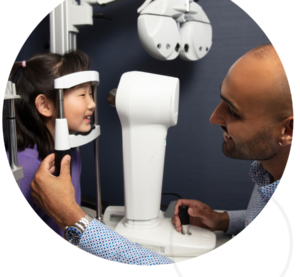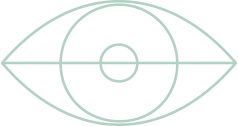Myopia Control: What Parents Need to Know
Myopia is a common refractive error in Australia and globally. Approximately 6.3 million Australians have myopia. Globally, over one-third of the world’s population has myopia. This is projected to increase to 50% by 2050* with a significant portion of this population being young children. It is important for parents to recognise the signs of myopia and know intervention strategies to ensure good eye health. In this blog, I will discuss myopia control strategies for children and what parents need to know about eye health.
What is myopia?
Myopia, also known as nearsightedness or short-sightedness, is a common eye condition where distant objects appear blurry and nearer objects are clear. This is because when the eyeball grows too long, light enters the eye and focuses in front of the retina, instead of directly on it. People notice they have myopia when they have trouble viewing objects that are farther away, like road signs or grocery store aisle markers.

FIG 1. NORMAL EYE

FIG 2. MYOPIC EYE
Myopia in children
In children, myopia typically develops before the age of 10. It then progresses every few months in children and teenagers and tends to stabilise in adulthood. While children do not outgrow myopia, their vision stabilises as they get older.
In children, eyes are meant to grow steadily and stabilise by their late teenage years. Myopic eyes grow too quickly and cause deterioration of vision.
Along with children needing glasses, myopia increases the chances of severe eye conditions like cataracts, glaucoma, macular issues, and retinal detachment. As myopia increases, so do these risks. The sooner we can detect and control myopia, the better our chances for eye health.
Can myopia in children be cured?
A lot of parents wonder that if caught early, can myopia be cured? Apart from surgery, there is no cure for myopia. There are tools to manage myopia, such as prescription glasses, contact lenses or ortho-k.
What causes myopia in children?
It is hard to pinpoint one cause of myopia. Many factors cause the development and progression of myopia, such as:
- Prolonged reading, screen time, or other near work can contribute to myopia development as the eye adapts to prolonged focusing at close objects.
- Myopia tends to run in families. If one or both parents have myopia, the child is at higher risk of developing it.
- Not spending enough time outdoors contributes to myopia progression.
- Injuries or trauma to the eye can cause changes in its shape and potentially lead to myopia.
Is myopia genetic?
Genes are one factor in the development of myopia. A child with one or both parents with myopia is more likely to develop myopia themselves. But genetics alone cannot cause myopia. There are other environmental factors that can cause myopia in children, like screen time.
Recognising the signs of myopia in children
- Eye rubbing, squinting or closing one eye to see
- Having trouble seeing the board in class
- Sitting too close to the TV and squinting to see clearly
- Headaches after using screens
- Holding a book or device too close to see it clearly
Myopia control in children
Myopia control involves a combination of lifestyle changes and proactive eye care. Here are different interventions to slow the progression of myopia in children:
- Regular eye exams monitor vision changes and catch any early signs of myopia. For children, we recommend annual eye exams. If your child already has myopia, we recommend 6-monthly eye exams. Early detection can help keep myopia at a low level — or, in some cases, prevent it from developing at all.
- Encourage children to spend at least 90 minutes outdoors daily. Time spent outside, especially in natural sunlight, helps balance out long hours spent indoors and in front of screens. Outdoor activities and sports also make children focus on distant objects and activities. For young children, exposure to sunlight also stimulates the production of dopamine, which supports the growth of the eye.*
- Screens are a part of daily life, but we need a good balance to maintain eye health. For children, it is important to take breaks, whether it’s using screens for school or video games.
- Lastly, children should be proactive with their eye health. This includes wearing prescribed glasses or contact lenses as recommended by their optometrist.
Can diet control myopia progression?
There is very limited research around the direct relationship between diet and myopia in kids. Diet or certain foods cannot prevent or cure myopia. A balanced diet, rich in essential nutrients, can support overall eye health.

How to talk to your children about eye health
Talking to your children about eye health, especially younger children and teenagers, is challenging for any parent. Everyone uses devices in the household. I often tell parents that cutting down on screen time and inculcating healthy habits requires a team effort. It helps when screen rules are set for the family, instead of parents setting rules only for children.
Here are some tips on how to talk to your children about eye health.
- Explain myopia in simple terms, like how myopia happens and why it’s important to manage it. For younger children, using diagrams, videos, or age-appropriate books can help them understand how lifestyle affects their eyes.
- Involve children in creating screen-time rules and outdoor time. This will help them feel like they’re a part of the decision-making process, rather than having to follow a set of rules from mum and dad.
- Create a routine and make outdoor time and screen breaks a consistent part of the day so it becomes second nature.
- Children learn best when they watch their parents model good habits. Let them see you taking eye breaks and choosing outdoor activities over screens when possible.
- Reinforce their efforts and praise positive choices.
What if children need screens for school?
I often get asked about kids using screens for school. If your child needs laptops and screens for school, it is important to teach them good screen hygiene. One easy trick is to use the 20-20-20 rule. Teach kids to look at something 20 feet away for 20 seconds every 20 minutes. This helps reduce eye strain. They can set reminders or use apps that prompt breaks.
I always advise parents that when children are studying at home or using screens, laptops should be positioned about 50–60 cm away. Monitors should be placed slightly farther — about 60–80 cm away — and the top of the screen should be at or just below eye level. Choose monitors over tablets when possible, as larger screens are easier on the eyes. Make sure the study space is well-lit and avoid using screens in dim lighting or areas with strong glare.
Conclusion
As parents, staying informed and proactive about eye care can make a significant difference when it comes to myopia control in kids. Understanding the causes, recognising early signs, and implementing practical myopia control strategies can help slow its progression. While myopia can’t be cured, it can be managed effectively with the right tools and habits. By working together with your child and your optometrist, you can protect your child’s sight and build healthy routines that benefit the whole family.
Contact Vision Camberwell to book an appointment. Our optometrists can provide ongoing guidance and support for myopia.
*References:
- https://www.sciencedirect.com/science/article/pii/S0161642016000257
- https://www.cera.org.au/conditions/myopia-and-refractive-error/#:~:text=Approximately%206.3%20million%20Australians%20are,can%20help%20protect%20your%20vision.
- https://www.mykidsvision.org/knowledge-centre/indoor-and-outdoor-lighting-and-visual-development






